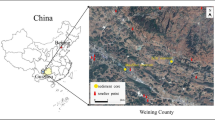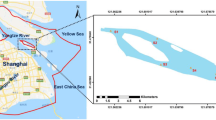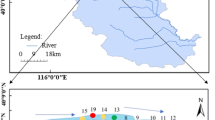Abstract
Purpose
In complex watersheds with multiple types of waterbodies, the effect of river damming on the distribution pattern of heavy metals in sediments and their potential ecological risks are inconsistent, leading to an inability to accurately manage heavy metal pollution. The aim of this study was to reveal the driving mechanisms of hydropower reservoirs on the distribution of heavy metals in sediments and their ecological risks.
Materials and methods
Characterization of the spatial distribution patterns of Cd, Cr, Cu, Ni, Pb, and Zn and evaluation of their ecological risks in surface sediments were conducted to explore the role of dam construction and operation in modulating heavy metal pollution in the Jiulong River Basin (JRB) using sequentially extracted European Community Bureau of Reference (BCR) extraction scheme, geo-accumulation index (Igeo), and potential ecological risk (RI).
Results and discussion
The results showed that hotspot patchiness pattern of sediment heavy metal contents highly matched the reservoir distribution but not for the non-dammed south river of the JRB. Ecological risk assessment demonstrated the RI of sediment heavy metals in the reservoir was markedly higher than those in the mainstream and its tributary (p < 0.05), and the potential ecological risks were dominated by Cd, followed by Pb in the sediments of three waterbodies (reservoir, mainstream, tributary). Moreover, BCR heavy metal fractionation showed bioavailability of heavy metals in Xipi Reservoir sediments was much greater than that in downstream reservoir sediments. The reason for this phenomenon was mainly attributed to the elongation of hydraulic residence time (HRT) in this reservoir, which promoted suspended solid sorting by grain size and consequent deposition, facilitating adsorption of finer sediments, with more bioavailable heavy metals falling onto the upper sediment layer in the reservoir.
Conclusions
In brief, dam construction and operation reinforced the accumulation of heavy metals and aggravated potential ecological risks in reservoir surface sediments. These findings deepen current understanding of the driving mechanism of reservoirs for sediment heavy metal pollution and confer the probability to precisely control sediment heavy metal pollution for management practices in the multitype waterbody catchment.







Similar content being viewed by others
References
Akbarzadeh Z, Maavara T, Slowinski S, Van Cappellen P (2019) Effects of damming on river nitrogen fluxes: a global analysis. Global Biogeochem Cy 33(11):1339–1357. https://doi.org/10.1029/2019gb006222
Carneiro FM, Bini LM (2020) Revisiting the concept of longitudinal gradients in reservoirs. Acta Limnol Brasil 32:e8. https://doi.org/10.1590/s2179-975x1319
Chen JS, Cao WZ, Cao D, Huang Z, Liang Y (2015) Nitrogen loading and nitrous oxide emissions from a river with multiple hydroelectric reservoirs. Bull Environ Contam Toxicol 94(5):633–639. https://doi.org/10.1007/s00128-015-1525-5
Chen ZJ, Chen CS, Liu YQ, Wu YD, Yang SK, Lu CY (1992) Study on soil environmental background values. Chin J Environ Sci 13(4):70–75
Deng MH, Yang X, Dai X, Zhang Q, Malik A, Sadeghpour A (2020) Heavy metal pollution risk assessments and their transportation in sediment and overlay water for the typical Chinese reservoirs. Ecol Indic 112:106166. https://doi.org/10.1016/j.ecolind.2020.106166
Fan JY, Jian X, Shang F, Zhang W, Zhang S, Fu HJ (2020) Underestimated heavy metal pollution of the Minjiang River. SE China: evidence from spatial and seasonal monitoring of suspended-load sediments Sci Total Environ. https://doi.org/10.1016/j.scitotenv.2020.142586
Gratacós O, Bitzer K, Casamor JL, Cabrera L, Calafat A, Canals M, Roca E (2009) Simulating transport and deposition of clastic sediments in an elongate basin using the SIMSAFADIM-CLASTIC program: The Camarasa artificial lake case study (NE Spain). Sediment Geol 222(1):16–26. https://doi.org/10.1016/j.sedgeo.2009.05.010
Håkanson L (1980) An ecological risk index for aquatic pollution control. A sedimentological approach. Water Res 14(8):975–1001. https://doi.org/10.1016/0043-1354(80)90143-8
Horváth M, Halász G, Kucanová E, Kuciková B, Fekete I, Remeteiová D, Heltai G, Flórián K (2013) Sequential extraction studies on aquatic sediment and biofilm samples for the assessment of heavy metal mobility. Microchem J 107:121–125. https://doi.org/10.1016/j.microc.2012.05.024
Huang X, Liang K, Liu X (2006) The distribution and assessment of heavy metals in surficial sediments in the pearl river estuary. Trans Oceanol Limnol (03):27–36. https://doi.org/10.13984/j.cnki.cn37-1141.2006.03.005
Hussein AM, Neama Jabbar D, Ali AR (2020) Spatial distribution and evaluation of heavy metals in surface sediments of the Al-Najaf sea depression reservoir, Iraq. Alexandria Eng J. https://doi.org/10.1016/j.aej.2020.09.049
Isabwe A (2014) Assessing the effects of dams on water discharge and sediment load variability in the Jiulong River. Master of Science Thesis, Coastal and Ocean Management Institute, Xiamen University, China
Kamidis N, Sylaios G (2017) Impact of river damming on sediment texture and trace metals distribution along the watershed and the coastal zone of Nestos River (NE Greece). Environ Earth Sci 76(10). https://doi.org/10.1007/s12665-017-6707-5
Krishna AK, Mohan KR (2013) Metal contamination and their distribution in different grain size fractions of sediments in an industrial development area. Bull Environ Contam Toxicol 90(2):170–175. https://doi.org/10.1007/s00128-012-0900-8
Kumar V, Parihar RD, Sharma A, Bakshi P, Singh Sidhu GP, Bali AS, Karaouzas I, Bhardwaj R, Thukral AK, Gyasi-Agyei Y, Rodrigo-Comino J (2019) Global evaluation of heavy metal content in surface water bodies: a meta-analysis using heavy metal pollution indices and multivariate statistical analyses. Chemosphere 236:124364. https://doi.org/10.1016/j.chemosphere.2019.124364
Li Y, Cao WZ, Su CX, Hong HS (2011) Nutrient sources and composition of recent algal blooms and eutrophication in the northern Jiulong River. Southeast China. Mar Pollut Bull 63(5):249–254. https://doi.org/10.1016/j.marpolbul.2011.02.021
Li YY, Gao B, Xu DY, Peng WQ, Liu XB, Qu XD, Zhang M (2020) Hydrodynamic impact on trace metals in sediments in the cascade reservoirs. North China. Sci Total Environ 716:136914. https://doi.org/10.1016/j.scitotenv.2020.136914
Li ZY, Huo JX, Bricker JD (2019) Ecological risk assessment for eutrophication and heavy metal pollution of Suyahu Reservoir sediments. Biotechnol Biotechnol Equip 33(1):1053–1062. https://doi.org/10.1080/13102818.2019.1638833
Liang B, Han GL, Liu M, Yang KH, Li XQ, Liu JK (2020) Source identification and water-quality assessment of dissolved heavy metals in the Jiulongjiang River. Southeast China. J Coastal Res 36(2):403–410. https://doi.org/10.2112/jcoastres-d-19-00068.1
Liao XY, Chen TB, Xie H, Liu YR (2005) Soil as contamination and its risk assessment in areas near the industrial districts of Chenzhou City. Southern China. Environ Int 31(6):791–798. https://doi.org/10.1016/j.envint.2005.05.030
Lin C, Li H, Chen JM, Chen WF, Lin LB, Ji WD (2011) Pollution assessment of heavy metals in the sediment of Jiulong River Estuary. Chin J Mar Sci 35(8):11–17
Lin CQ, Hu GR, Yu RL, Yang QL, Yu WH (2016) Pollution assessment and source analysis of heavy metals in offshore surface sediments from Jiulong River. Chin J Environ Sci 36(4):1218–1225. https://doi.org/10.3969/j.issn.1000-6923.2016.04.038
Lin CQ, Hu GR, Yu RL, Han L (2017) Speciation and ecological risk of heavy metals in surface sediments from Jiulong River. Chin J Environ Sci 38(3):1002–1009. https://doi.org/10.13227/j.hjkx.201607087
Lin L, Wang FF, Chen H, Fang H, Zhang TY, Cao WZ (2021) Ecological health assessments of rivers with multiple dams based on the biological integrity of phytoplankton: a case study of North Creek of Jiulong River. Ecol Indic 121:106998. https://doi.org/10.1016/j.ecolind.2020.106998
Liu MD, He YP, Baumann Z, Zhang QR, Jing X, Mason RP, Xie H, Shen HZ, Chen L, Zhang W, Zhang QG, Wang XJ (2020) The impact of the Three Gorges Dam on the fate of metal contaminants across the river–ocean continuum. Water Res 185:116295. https://doi.org/10.1016/j.watres.2020.116295
Lu WW, Lei HM, Yang DW, Tang LH, Miao QH (2018) Quantifying the impacts of small dam construction on hydrological alterations in the Jiulong River basin of Southeast China. J Hydrol 567:382–392. https://doi.org/10.1016/j.jhydrol.2018.10.034
Maavara T, Parsons CT, Ridenour C, Stojanovic S, Dürr HH, Powley HR, Van Cappellen P (2015) Global phosphorus retention by river damming. Proc Natl Acad Sci USA 112:15603–15608. https://doi.org/10.1073/pnas.1511797112/-/DCSupplemental
Maavara T, Lauerwald R, Regnier P, Van Cappellen P (2017) Global perturbation of organic carbon cycling by river damming. Nat Commun 8(1):15347. https://doi.org/10.1038/ncomms15347
Maavara T, Akbarzadeh Z, Van Cappellen P (2020a) Global dam-driven changes to riverine N:P:Si ratios delivered to the coastal ocean. Geophys Res Lett 47:e2020GL088288. https://doi.org/10.1029/2020gl088288
Maavara T, Chen QW, Meter KV, Brown LE, Zarfl C (2020b) River dam impacts on biogeochemical cycling. Nat Rev Earth Environ 1:103–116. https://doi.org/10.1038/s43017-019-0019-0
Mossop KF, Davidson CM (2003) Comparison of original and modified BCR sequential extraction procedures for the fractionation of copper, iron, lead, manganese and zinc in soils and sediments. Anal Chim Acta 478(1):111–118. https://doi.org/10.1016/S0003-2670(02)01485-X
Müller G (1969) Index of geoaccumulation in sediments of the Rhine River. Geol J 2:109–118
Mulligan M, van Soesbergen A, Saenz L (2020) GOODD, a global dataset of more than 38,000 georeferenced dams. Sci Data 7(1):31. https://doi.org/10.1038/s41597-020-0362-5
Nogueira MG, Oliveira PCR, Britto YTD (2008) Zooplankton assemblages (Copepoda and Cladocera) in a cascade of reservoirs of a large tropical river (SE Brazil). Limnetica 27(1):151–170. https://doi.org/10.23818/limn.27.13
Paul V, Sankar MS, Vattikuti S, Dash P, Arslan Z (2021) Pollution assessment and land use land cover influence on trace metal distribution in sediments from five aquatic systems in Southern USA. Chemosphere 263:128243. https://doi.org/10.1016/j.chemosphere.2020.128243
Peng BR, Chen NW, Lin H, Hong HS (2013) Empirical appraisal of Jiulong River Watershed management program. Ocean Coastal Manage 81:77–89. https://doi.org/10.1016/j.ocecoaman.2012.06.013
Raj D, Maiti SK (2020) Sources, bioaccumulation, health risks and remediation of potentially toxic metal(loid)s (As, Cd, Cr, Pb and Hg): an epitomised review. Environ Monit Assess 192(2):108. https://doi.org/10.1007/s10661-019-8060-5
Roig N, Sierra J, Ortiz JD, Merseburger G, Schuhmacher M, Domingo JL, Nadal M (2013) Integrated study of metal behavior in Mediterranean stream ecosystems: a case-study. J Hazard Mater 263:122–130. https://doi.org/10.1016/j.jhazmat.2013.07.051
Roig N, Sierra J, Moreno-Garrido I, Nieto E, Gallego EP, Schuhmacher M, Blasco J (2016) Metal bioavailability in freshwater sediment samples and their influence on ecological status of river basins. Sci Total Environ 540:287–296. https://doi.org/10.1016/j.scitotenv.2015.06.107
Satarug S, Baker JR, Urbenjapol S, Haswell-Elkins M, Reilly PEB, Williams DJ, Moore MR (2003) A global perspective on cadmium pollution and toxicity in non-occupationally exposed population. Toxicol Lett 137(1):65–83. https://doi.org/10.1016/S0378-4274(02)00381-8
Thornton KW, Kennedy RH, Carroll JH, Walker WW, Gunkel RC, Ashby S (1981) Reservoir sedimentation and water quality - an heuristic model. Water Sci Technol 1:654–661
Timpe K, Kaplan D (2017) The changing hydrology of a dammed Amazon. Sci Adv 3(11):e1700611. https://doi.org/10.1126/sciadv.1700611
Ure AM, Quevauviller P, Muntau H, Griepink B (1993) Speciation of heavy metals in soils and sediments. An account of the improvement and harmonization of extraction techniques undertaken under the auspices of the BCR of the Commission of the European Communities. Int J Environ Anal Chem 51(1–4):135–151. https://doi.org/10.1080/03067319308027619
Varol M (2020) Environmental, ecological and health risks of trace metals in sediments of a large reservoir on the Euphrates River (Turkey). Environ Res 187:109664. https://doi.org/10.1016/j.envres.2020.109664
Vukovic D, Vukovic Z, Stankovic S (2014) The impact of the Danube Iron Gate Dam on heavy metal storage and sediment flux within the reservoir. Catena 113:18–23. https://doi.org/10.1016/j.catena.2013.07.012
Wang GH, Fang QH, Zhang LP, Chen WQ, Chen ZM, Hong HS (2010) Valuing the effects of hydropower development on watershed ecosystem services: case studies in the Jiulong River Watershed, Fujian Province. China. Estuarine Coastal Shelf Sci 86(3):363–368. https://doi.org/10.1016/j.ecss.2009.03.022
Wang S, Hu GR, Yu RL, Yu WH, Zhou CF (2014) Pollution assessment and source analysis of heavy metals in surface sediments from Jiulong River Estuary. Chin J Res Environ Sci 27(10):1110–1118. https://doi.org/10.13198/j.issn.1001-6929.2014.10.04
Wang Y, Lian YT, Feng Q, Wang ZJ, Zhao WJ, Liu JJ, Lu SG, Zhang XY (2019) Effects of dam interception on the spatial distribution of sediment granularities in Heihe River. Chin J Lake Sci 31(5):1459–1467. https://doi.org/10.18307/2019.0505
Xu ZH, Yu CX, Sun H, Yang ZF (2020) The response of sediment phosphorus retention and release to reservoir operations: numerical simulation and surrogate model development. J Cleaner Prod 271:122688. https://doi.org/10.1016/j.jclepro.2020.122688
Yan YY, Guan QS, Wang M, Su XL, Wu GJ, Chiang PC, Cao WZ (2018) Assessment of nitrogen reduction by constructed wetland based on InVEST: a case study of the Jiulong River Watershed, China. Mar Pollut Bull 133:349–356. https://doi.org/10.1016/j.marpolbul.2018.05.050
Yang P, Yang CH, Yin HB (2020) Dynamics of phosphorus composition in suspended particulate matter from a turbid eutrophic shallow lake (Lake Chaohu, China): implications for phosphorus cycling and management. Sci Total Environ 741:140203–140203. https://doi.org/10.1016/j.scitotenv.2020.140203
Yang XK, Lu XX (2014) Drastic change in China’s lakes and reservoirs over the past decades. Sci Rep 4:6041. https://doi.org/10.1038/srep06041
Yi YJ, Yang ZF, Zhang SH (2011) Ecological risk assessment of heavy metals in sediment and human health risk assessment of heavy metals in fishes in the middle and lower reaches of the Yangtze River basin. Environ Pollut 159(10):2575–2585. https://doi.org/10.1016/j.envpol.2011.06.011
Zarfl C, Lumsdon AE, Berlekamp J, Tydecks L, Tockner K (2015) A global boom in hydropower dam construction. Aquat Sci 77(1):161–170. https://doi.org/10.1007/s00027-014-0377-0
Zhang KB (2008) Geochemistry environment quality of littoral and neritic sediments in Fujian province. Mar Geol Quat Geol 28(2):45–52. https://doi.org/10.16562/j.cnki.0256-1492.2008.02.009
Zhang Q, Han GL, Liu M, Li XQ, Wang LQ, Liang B (2019) Distribution and contamination assessment of soil heavy metals in the Jiulongjiang River Catchment, Southeast China. Int J Env Res Public Health 16(23):4674. https://doi.org/10.3390/ijerph16234674
Zhu L, Liu JW, Xu SG, Xie ZG (2017) Deposition behavior, risk assessment and source identification of heavy metals in reservoir sediments of Northeast China. Ecotoxicol Environ Saf 142:454–463. https://doi.org/10.1016/j.ecoenv.2017.04.039
Acknowledgements
The authors are grateful to Dr. Christine Watts and Mrs. Xiaona Zhang for proofreading the manuscript.
Funding
This research was jointly supported by the National Natural Science Foundation of China (91547206, 51709183), the Science and Technique Foundation of Fujian Province (2020R1025001), and the 61st China Postdoctoral Science Foundation (2017M611862), and the Research Project of Fujian Academy of Agricultural Sciences (YC2019007, ZYTS2019016, STIT2017-1-9).
Author information
Authors and Affiliations
Contributions
Qiuwen Chen and Juhua Yu: funding acquisition, conceptualization and manuscript writing. Dejun Kang and Gongyi Zheng: writing the original draft. Xiangzhou Zheng, Jicheng Zhong, and Yushu Zhang: field investigation, laboratory analysis. Hong Ding and Yinlong Zhang: review and editing.
Corresponding authors
Ethics declarations
Conflict of interest
The authors declare no competing interests.
Additional information
Responsible editor: Hongbin Yin
Publisher's Note
Springer Nature remains neutral with regard to jurisdictional claims in published maps and institutional affiliations.
Supplementary information
Below is the link to the electronic supplementary material.
Rights and permissions
About this article
Cite this article
Kang, D., Zheng, G., Yu, J. et al. Hydropower reservoirs enhanced the accumulation of heavy metals towards surface sediments and aggravated ecological risks in Jiulong River Basin, China. J Soils Sediments 21, 3479–3492 (2021). https://doi.org/10.1007/s11368-021-03002-0
Received:
Accepted:
Published:
Issue Date:
DOI: https://doi.org/10.1007/s11368-021-03002-0




